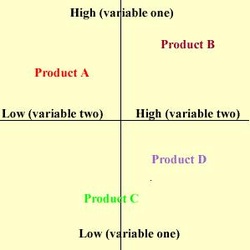PRODUCT POSITIONING MAPPositioning is undoubtedly one of the simplest and most useful tools to marketers. After segmenting a market and then targeting a consumer, you would proceed to position a product within that market. Remember this important point. Positioning is all about 'perception'. As perception differs from person to person, so do the results of the positioning map e.g what you perceive as quality, value for money, etc, and is different to my perception. However, there will be similarities. Products or services are 'mapped' together on a 'positioning map'. This allows them to be compared and contrasted in relation to each other. This is the main strength of this tool. Marketers decide upon a competitive position which enables them to distinguish their own products from the offerings of their competition (hence the term 'positioning strategy'). Look at the basic positioning map template below. The marketer would draw out the map and decide upon a label for each axis. They could be price (variable
one) and quality (variable two), or Comfort (variable one) and price (variable two). The individual products are then mapped out next to each other. Any gaps could be regarded as possible areas for new products. The term 'positioning' refers to the consumer's perception of a product or service in relation to its competitors. You need to ask yourself, what is the position of the product in the mind of the consumer? Trout and Ries suggest a six-step question framework for successful positioning: 1. What position do you currently own? 2. What position do you want to own? 3. Whom you have to defeat to own the position you want. 4. Do you have the resources to do it? 5. Can you persist until you get there? 6. Are your tactics supporting the positioning objective you set? Look at the example below using the auto market PRODUCT: FERRARI, BMW, PROTON, MERCURY COUGAR, HYUNDAI, DAEWOO. The seven products are plotted upon the positioning map. It can be concluded that products tend to bunch
in the high price/low economy (fast) sector and in the low price/high economy sector. There is an opportunity in the low price/ low economy (fast) sector. Maybe Hyundai or Daewoo could consider introducing a low cost sport saloon. However, remember that it is all down to the perception of the individual. |
|
- Home
-
Applied Analytics
-
Analytics for Decision Making
>
- What is Cluster Analysis
- Data Reduction and Unsupervised Learning
- Preparing Data and Measuring Dissimilarities
- Hierarchical and k-Means Clustering
- Defining Output Variables and Analyzing the Results
- Using Historical Data to Model Uncertainty
- Models with Correlated Uncertain Variables
- Creating and Interpreting Charts
- Using Average Values versus Simulation
- Optimization and Decision Making
- Formulating an Optimization Problem
- Developing a Spreadsheet Model
- Adding Optimization to a Spreadsheet Model
- What-if Analysis and the Sensitivity Report
- Evaluating Scenarios and Visualizing Results to Gain Practical Insights
- Digital Marketing Application of Optimization
- Advanced Models for Better Decisions
- Business Problems with Yes/No Decisions
- Formulation and Solution of Binary Optimization Problems
- Metaheuristic Optimization
- Chance Constraints and Value At Risk
- Simulation Optimization
-
Analytics for Marketing
>
- Marketing Analytics and Customer Satisfaction
- Customer Satisfaction
- Measurements and Scaling Techniques – Introduction
- Primary Scales of Measurement
- Comparative Scaling
- Non-Comparative Scaling
- Experiment Design: Controlling for Experimental Errors
- A/B Testing: Introduction
- A/B Testing: Types of Tests
- ANOVA – Introduction
- Example -Inspect Spray and Tooth Growth
- Logit Model - Binary Outome and Forecastign linear regression
- Text Summarization
- Social media Microscope
- N-Gram - Frequcy Count and phase mining
- LDA Topic Modeling
- Machine-Learned Classification and Semantic Topic Tagging
- Data Engine >
-
Customer Insights
>
- Introduction
- What is Descriptive Analytics?
- Survey Overview
- Net Promoter Score and Self-Reports
- Survey Design
- Passive Data Collection
- Media Planning
- Data Visualization
- Causal Data Collection and Summary
- Asking Predictive Questions
- Regression Analysis
- Data Set Predictions
- Probability Models
- Results and Predictions
- Perspective Analytics (Maximize Revenue and Market Structure Competitions)
-
Analytics for Advance Marketing
>
- Visualisation and statistics (Political Advertising,Movie Theater and Data Assembly)
- Excel Analysis of Motion Picture Industry Data
- Displaying Conditional Distributions
- Analyzing Qualitative Variables
- Steps in Constructing Histograms
- Common Descriptive Statistics for Quantitative Data
- Regression-Based Modeling
- Customer Analytics
- Illustrating Customer Analytics in Excel
- Customer Valuation Excel Demonstration
-
Analytics for Decision Making
>
- Soft Skills
- Marketing
- Finance
-
Economics
- JBDON Golf
- Let's Talk
- MBA Project Sharing
-
About Us
-
Good Read
>
- IIMC says PepsiCo CEO Indra Nooyi was an average student
- India’s middle class figures in Fortune’s Top Ten list of those who matter
- The Start-Up of you.
- BUYING AND MERCHANDISING
- HUMAN RESOURCE MANAGEMENT
- Do You Suffer From Decision Fatigue?
- New Page
- About social media and web 2.0
- Building Your Own Start-up Technology Company, Part 1
- Building Your Own Start-up Technology Company, Part 2
- Building Your Own Start-up Technology Company, Part 3
- Building Your Own Start-up Technology Company, Part 4
- Renewable energy is no longer alternative energy
- What Makes an Exceptional Social Media Manager?
- The Forgotten Book that Helped Shape the Modern Economy
- Home
- How to Think Creatively
- A Lighthearted Looks at Project Management and Sports Analogies
- Why Trust Matters More Than Ever for Brands
-
Good Read
>
- CET Knowledge Zone
- Untitled
- New Page
- Adidas


